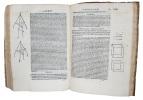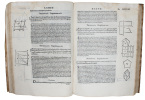EUCLID OF ALEXANDRIA.
Evclide Megarense Philosopho: solo introdvtttore delle Scientie Mathematice" diligentemente Reassettato, et alla integrita ridotto per il degno Professore di tal Scientie Nicolo Tartalea, Brisciano, Secondo le due Tradottioni: e per commune commodo & ... - [FIRST ""EUCLID"" IN THE VERNACULAR BY TARTAGLIA.]
(Colophon: Venice, Venturino Rossenelli, 1543). Folio. (30,5x22 cm.). Contemporary full Italian limp vellum. Remains of ties. Old handwritten title on spine. Upper part of frontcover slightly creased. A few small nicks to hinges at cords. Vellum with brownspots. 242 leaves (2-241 numb. II-CCXXXIX). Misnumbering of leaves in sign. A (10 lvs.), due to the insertion of corrections on f A5. (Collation corresponds to that given by Thomas-Stanford No. 34). Large margins profusely illustrated with diagrams. Upper right corner of title gone with loss of of 3 letters ""NSE"" in MEGARENSE, f A2-A6 with upper right corners and a wormtract-hole in lower margin repaired. A wormtract in lower margin on the next 11 lvs. A1-A6 mounted skillfully on thin opaque parchment-paper. A rather faint dampstain in upper right corner throughout. Last 5 leaves with a small nick in right margin, no loss. Otherwise remarkable clean and printed on good strong paper. On the title a large woodcut device with arms with G.T. (Gabriele Tadino, to whom the work is dedicated). Colophon with large woodcut device with the letters .P.Z.F. and this repeated on verso of last leaf.
Reference : 34704
Scarce first edition of the first translation of Euclid in any modern language by the famous Niccolo Tartaglia. The translation and Tartaglia's commentaries, strongly accelerated the development of physics and mechanics in the 16th century, as it showed how mathematics could be applied to dynamics and mechanics as well as to architecture, construction and perspective. More than 20 years should elapse before the next language should receive the privilege of displaying Euclid among their goods, this was the French translation published by Pierre Forcadel, Paris 1564. ""When Tartaglia submits that his redaction was made ""secondo le due tradittioni"", there is no question that Campanus - who appears to be heavely favored - and Zamberti are meant. When Campanus has added propositions or premises, Tartaglia has approriately translated them and noted their absence ""nelle seconda tradittione"", while things omitted by Campanus but included by Zamberti receive the reverse treatment"" (John Murdoch in DSB).Niccolo Fontana Tartaglia of Brescia has a great name in the history of mathematics. A cut in the face from a French soldier caused him to stammer and as a consequence of this he was called 'Tartaglia' (the stammerer). He is famous for his solution of third-degree equations which occasioned a long polemic with Cardano about priority. He is also known for ""Tartaglia's Triangle"", later known as ""Pascal's Triangle"", and he is well-known for his Archimedes-edition of 1543 and 1551 with his commentaries.""The most famous source of Greek geometry is the monumental work of Euclid of Alexandria, called the ""Elements"" (around 300 B.C.). No other book of science had a comparable influence on the intellectual development of mankind. It was a treatise of geometry in thirteen books which included all the fundamental results of scientific geometry up to his time. Euclid did not claim for himself any particular discovery, he was merely a compiler. Yet, in view of the systematic arrangement of the subject matter and the exact logical procedure followed, we cannot doubt that he himself provided a large body of specific formulations and specific auxiliary theorems in his deductions. It is no longer possible to pass judgement on the authorship of much of this material"" his book was meant as a textbook of geometry which paid attention to the material, while questions of priority did not enter the discussion."" (Cornelius Lanzos in ""Space through the Ages"").Max Steck III:40 - Thomas-Stanford: 34 - Riccardi Euclideana 1543, 1 - Adams E:992. - Brunet II:1090. (Premiere edition de ce travail estimé). - Graesse II:513.
Bookseller's contact details
Herman H. J. Lynge & Son
William Schneider
Silkegade 11
1113 Copenhagen
Denmark
+45 33 155 335
Payment mode
Sale conditions
All items may be returned for a full refund for any reason within 14 days of receipt.
 Write to the booksellers
Write to the booksellers






